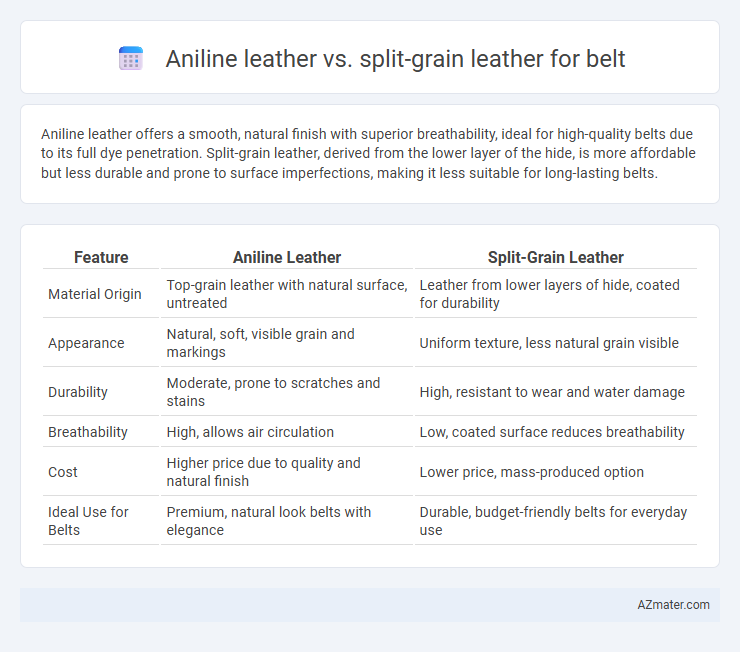Aniline leather offers a smooth, natural finish with superior breathability, ideal for high-quality belts due to its full dye penetration. Split-grain leather, derived from the lower layer of the hide, is more affordable but less durable and prone to surface imperfections, making it less suitable for long-lasting belts.
Table of Comparison
| Feature | Aniline Leather | Split-Grain Leather |
|---|---|---|
| Material Origin | Top-grain leather with natural surface, untreated | Leather from lower layers of hide, coated for durability |
| Appearance | Natural, soft, visible grain and markings | Uniform texture, less natural grain visible |
| Durability | Moderate, prone to scratches and stains | High, resistant to wear and water damage |
| Breathability | High, allows air circulation | Low, coated surface reduces breathability |
| Cost | Higher price due to quality and natural finish | Lower price, mass-produced option |
| Ideal Use for Belts | Premium, natural look belts with elegance | Durable, budget-friendly belts for everyday use |
Introduction to Leather Types: Aniline vs Split-Grain
Aniline leather is crafted from full-grain hides dyed with soluble aniline dyes, preserving natural markings and providing a soft, breathable surface ideal for premium belts. Split-grain leather, derived from the fibrous lower layer of a hide, undergoes sanding or embossing to mask imperfections, resulting in a more uniform but less durable material. Choosing between aniline and split-grain leather depends on preferences for natural appearance, durability, and budget in belt craftsmanship.
What is Aniline Leather?
Aniline leather is a type of high-quality leather dyed exclusively with soluble dyes, retaining the hide's natural surface and grain, giving it a soft, breathable, and supple texture ideal for belts. This leather showcases the natural imperfections and markings of the animal hide, resulting in a unique and luxurious appearance that improves with age. In contrast to split-grain leather, which is made from the lower layers and often coated for durability, aniline leather offers superior comfort and aesthetic appeal but requires careful maintenance to protect its delicate surface.
What is Split-Grain Leather?
Split-grain leather is created by splitting the hide into layers, typically using the lower layers that lack the grain surface found in full-grain or aniline leather. This type of leather is less durable and more prone to wear but is often more affordable and easier to manipulate for items like belts. While aniline leather retains the natural grain and develops a rich patina over time, split-grain leather is usually coated or treated to improve its appearance and longevity.
Unique Characteristics of Aniline Leather
Aniline leather features a natural, untreated surface that retains the hide's original pores and markings, offering a soft, breathable texture ideal for premium belts. Its transparent dyeing process enhances the leather's natural beauty and patina over time, creating a unique, rich character that becomes more distinguished with wear. Unlike split-grain leather, which is made from the lower layers and often coated for durability, aniline leather maintains superior suppleness and an authentic appearance but requires more careful maintenance.
Key Features of Split-Grain Leather
Split-grain leather for belts is made from the lower layers of the hide, offering enhanced durability and resistance to wear compared to aniline leather. Its surface is often embossed or coated, providing better protection against stains and scratches while sacrificing some natural grain texture and breathability. This type of leather is ideal for belts requiring long-lasting strength and a more uniform appearance.
Appearance and Aesthetic Differences
Aniline leather displays a rich, natural surface with visible grain markings and a smooth, soft texture due to minimal processing and the absence of a pigmented surface coat. Split-grain leather, derived from the lower layers of the hide, has a more uniform but less natural appearance, often requiring heavy embossing and coatings to mimic top-grain qualities. For belts, aniline leather offers a luxurious, elegant look with organic variations, while split-grain tends to present a more manufactured, consistent finish lacking the depth and patina of full-grain aniline options.
Durability Comparison for Leather Belts
Aniline leather offers a natural, soft finish with high breathability but tends to be less durable for belts due to its minimal surface protection, making it prone to scratches and stains. Split-grain leather, derived from the lower layers of the hide, is typically treated or coated, providing enhanced resistance to wear, moisture, and abrasion, which increases its longevity in belt applications. For durability, split-grain leather belts outperform aniline leather belts, maintaining structural integrity and appearance over extended use.
Comfort and Wearability Factors
Aniline leather belts offer superior softness and breathability due to their minimal surface treatment, enhancing comfort during extended wear. Split-grain leather, though more durable and affordable, tends to be stiffer and less breathable, which can reduce overall wearability. The natural texture of aniline leather conforms better to body contours, providing a more comfortable fit compared to the rougher feel of split-grain belts.
Maintenance and Care Requirements
Aniline leather belts require gentle maintenance, using mild soaps and conditioners to prevent fading and maintain their natural, smooth finish, as they lack protective coatings. Split-grain leather, being more porous and less durable, demands more frequent conditioning and cleaning to avoid dryness and cracking, often benefiting from waterproofing treatments to extend its lifespan. Proper storage away from direct sunlight and moisture is essential for both types to preserve their appearance and structural integrity.
Which Leather is Best for Belts?
Aniline leather offers a natural, soft texture with a rich patina, making it ideal for high-quality belts that emphasize aesthetics and comfort. Split-grain leather, derived from the lower layers of the hide, is more affordable but less durable and prone to wear, often requiring additional coatings for protection. For belts, top-grain aniline leather is generally the best choice due to its combination of durability, flexibility, and premium appearance.

Infographic: Aniline leather vs Split-grain leather for Belt
 azmater.com
azmater.com